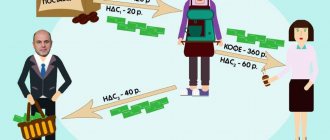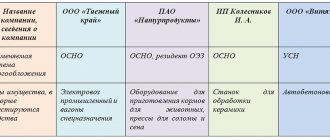Determination of the tax base
The section of the legislation of the Russian Federation devoted to taxation interprets in detail the concept of tax and all its elements. These issues are addressed in Article 8 of the Tax Code of the Russian Federation.
A tax is a mandatory fee established by the state for organizations and individuals, which provides for the contribution of a portion of their financial resources intended for the state budget.
Tax base is an element of tax that functions along with others:
- subject and object;
- rate;
- accounting tax period;
- method of accrual;
- features and timing of tax payments;
- possible benefits.
What is the tax base
The tax base characterizes the item subject to taxation in terms of quantity, value, physical properties or other characteristics. In other words, the tax base defines the units in which the object of taxation can be “measured.” the object of taxation is .
The item on which the tax is levied is called its object. It can be represented by various assets and financial amounts, for example:
- income, receipts, profit;
- cost of goods sold;
- payment received for services rendered or work performed;
- total income of an individual;
- own property owned by organizations and citizens;
- hereditary mass;
- vehicles, etc.
NOTE! Most often, the name of the tax reflects precisely its object: “income tax”, “land tax”, etc.
So, we conclude: the item on which tax must be paid is considered an object of taxation, and the tax base is its significant characteristic.
What is the tax rate
Tax rate in simple words
Officially speaking, tax rates are the amounts of payments per unit of the tax base.
In simple terms, this is a figure or coefficient on the basis of which tax authorities calculate how much money each person must pay to the budget. Different coefficients are used. Individual entrepreneurs pay at their own rates: from 6 to 15 percent of the income or profit received. Enterprises are required to contribute at least 20 percent of their income to the budget. Rates for individuals are determined by the type of taxation:
- Self-employed people pay 4-6 percent of their income to the budget,
- 13 percent is the amount of deduction from wages and most income.
Tax rates can be flat, that is, unchanged, at a predetermined amount. Or they can be interest-bearing, that is, calculated as a percentage of the amount earned or the value of the property. Most rates applied to individuals are percentage and fixed, while for enterprises the options may be different:
- progressive - the percentage of contributions to the budget increases with the growth of profits;
- regressive - as profits increase, the company pays a smaller percentage of income to the budget.
In addition, the rate can be differentiated, that is, its value depends on certain factors. For example, the tax rate on cars is differentiated; it is calculated depending on the engine power of the vehicle. A differentiated rate is also used to calculate land tax: for social lands the amount will be less than for commercial areas.
Who sets tax rates
Rates are set at the federal, regional and local levels. There are few federal ones, that is, established for all regions of the country:
- on the profits of organizations;
- value added (VAT);
- for mining;
- excise taxes
Only one of the list of rates established at the federal level applies to individuals - the tax rate for personal income tax, that is, on the income of individuals. For most income, including wages, income from renting an apartment or providing professional services, it is 13 percent of earnings. If a person lives abroad for most of the year, then the amount of contributions to the budget is increased to 35 percent.
Other rates are determined by regional and local authorities, but they cannot set any amounts. The Tax Code defines maximum limits. More is not possible, less is welcome.
At the regional level, the percentage of deductions for owning transport is determined, at the local level - for owning land and real estate.
Car tax rate
All owners pay a fee for owning vehicles, not only cars, but also buses, boats, motorcycles, trucks, snowmobiles and jet skis. Transport tax rates are differentiated and determined by engine power and vehicle capacity.
Calculate the cost amount in rubles for each horsepower using the following tax rates:
- 2.5 rubles - up to 100 horsepower;
- 3.5 rubles - 100-150 horsepower;
- 5 rubles - up to 200 horsepower.
The most expensive thing to own is a car with an engine power of 250 horsepower or more; the rate is 15 rubles per horsepower.
There is no need to calculate the amount of payment to the budget yourself; this is done by tax officials. They receive data from the traffic police after you register the vehicle.
By law, regional authorities can reduce the tax rate, make concessions for owners of old cars and apply benefits for people from certain categories, for example, pensioners, war veterans, large families. You can find out what benefits apply in your region on the Federal Tax Service website.
Tax rate on land in Russia
The right to set the tax rate is given to local authorities.
If the lands are classified as socially significant, that is, intended for residential construction and the organization of dacha cooperatives, the maximum rate cannot exceed 0.3 percent of the cadastral value of the site.
If the land is used for commercial activities, the rate can be a maximum of 1.5 percent of the cadastral price.
Despite the fact that these figures are the maximum, beyond which local authorities do not have the right to demand taxes, they are the ones used throughout Russia. Payments for land go to local budgets, and local authorities do not want to give up this source of income. But there are also benefits, some are established at the federal level, others at the local level. You can also view the list of land benefits in your region on the Federal Tax Service website.
Property tax rate
It is believed that taxes need to be paid only for an apartment, house or commercial premises, while other types of property are not subject to taxes. This opinion is wrong.
By law, you also have to pay the state for owning a room, a garage, or an unfinished building. If you built a house on a dacha plot, you also need to pay for it, since houses located on lands for personal peasant farming, in dacha and garden cooperatives, from the point of view of tax authorities, are considered residential.
The rate is set by local authorities, and from 2022 the amounts are calculated based on the cadastral value of the property. The rate cannot exceed:
- 0.1% for apartments, rooms, residential buildings, unfinished residential buildings, garages and outbuildings;
- 2% for objects worth over 300 million rubles.
Despite the minimum tax rate, the amounts of property taxes are significant, since the cadastral value, from which the tax fee is calculated, is close to the market value. Some categories of people are exempt from paying these contributions, and in a number of regions local benefits have been added to the federal benefits. You can find out what benefits for the property of individuals are valid in your region on the website of the Federal Tax Service.
How does the tax base affect the amount of tax?
Any payer is primarily concerned with the question: “Exactly how much will I need to pay?” The concept of the tax base coupled with the application of the tax rate is designed to answer this.
The amount of tax paid is the product of the tax base and the tax rate.
The tax base regulates the units in which the tax is calculated, and the tax rate , in turn, shows what proportion of these units must be allocated to the state. This relationship can be of two types:
- firm - the absolute amount for each unit of the tax base (more often used when calculating taxes, the base of which allows you to assign a fixed amount to each characteristic of the tax base, for example, transport, excise, land taxes);
- interest – one or another percentage of the entire quantitative expression of the tax base is subject to payment.
Types of interest rates
Depending on how the tax percentage is set, interest rates can be of different types:
- proportional - the same percentage is always deducted from the tax base as tax (examples - income tax, VAT);
- progressive - the higher the tax base, the greater the deductible percentage will be, and both the entire base and its individual parts can be taken into account (the modern Russian Tax Code does not apply rates of this type);
- regressive - the lower the tax base, the more the tax percentage will decrease.
Calculus errors
Tax authorities calculate the tax base on the basis of documents submitted monthly by payers for consideration. At the same time, if calculation errors are made, the responsibility falls squarely on the shoulders of the tax authorities.
They are required to identify the error and then correct it in a timely manner.
So, if a calculation error was discovered in the current period, but it is not possible to find in which period this error was made, then the recalculation is made on the basis of the current period. If it is possible to find when an error or distortion was made, then the recalculation is made precisely for this period.
This procedure is prescribed in Article 54 of the Tax Code. At the same time, payers are required to promptly submit documents on the basis of which the tax base is calculated. Accounting documents are considered to be accounting registers maintained by the organization's accountants, and not by the tax authorities. Tax authorities only accept registers for verification and calculation of the tax base.
For individual entrepreneurs, lawyers and notaries who provide services privately, the same rules for maintaining accounting registers are established, as well as tax rules, including the calculation of the tax base. In this case, both income and expenses are taken as a basis. This issue is controlled by the Ministry of Finance.
Author of the article
Elements that reduce the tax base
Naturally, for the taxpayer, from a financial point of view, it is more profitable for the tax base to be as small as possible, then a smaller amount of taxes will be paid from it. The law allows you to reduce the amount to be multiplied by the tax rate by the following economic values:
- tax deductions – it is allowed not to include categories of amounts specified by law in the taxable amount (these include standard deductions, pension, charitable, “children’s” and some others);
- tax benefits - financial advantages for certain categories established by the Government (lower tax amount, reduction of the tax rate, establishment of a minimum that is not subject to taxation, complete abolition of payment of a particular tax).
So, if we express the tax base as a formula, it will look like this:
NB = SD – V – L
Where:
- NB – tax base;
- B – tax deductions provided for by law and applicable to a given taxpayer;
- L – tax benefits valid for a given tax and category of payers.
Article 53 of the Tax Code of the Russian Federation. Tax base and tax rate, fees (current version)
The commented article defines such elements of taxation as the tax base and tax rate.
Taxes are calculated on the basis of the tax base, which recognizes the cost, physical or other characteristic of the object of taxation, the tax rate, which recognizes the amount of tax charges per unit of measurement of the tax base, as well as tax benefits (to which Article 56 of the Tax Code of the Russian Federation is devoted).
The Resolution of the Sixth Arbitration Court of Appeal dated October 9, 2012 N 06AP-4454/2012 states that since the tax base is the basis for calculating the amount of tax, since the tax rate is applied to it, the procedure for calculating the tax base is regulated by tax legislation.
The Resolution of the Eleventh Arbitration Court of Appeal dated 05/03/2012 N A72-7556/2011 noted that based on the definition of the tax base given in Article 53 of the Tax Code of the Russian Federation, as a cost, physical or other characteristic of the object of taxation, it can be argued that in the absence of an agreement with the counterparty It is also impossible to determine the tax base, since it is secondary in relation to the object of taxation and must also have a cost characteristic.
As explained in the Resolution of the Federal Antimonopoly Service of the Ural District dated January 17, 2013 N F09-13153/12, the legislation on taxes and fees of the Russian Federation does not provide for the determination of the tax base and, accordingly, the amount of taxes payable to the budget, only on the basis of information contained in the registers accounting, as well as tax reporting submitted to the tax authority.
The correctness of the data reflected in the accounting and tax reporting must be confirmed by relevant primary documents.
If discrepancies are identified between tax returns and accounting registers, the tax official conducting the audit must determine the reason for such discrepancy.
To do this, the taxpayer’s primary documents, which serve as the basis for the calculation and payment of tax, must be checked. Based on these documents, it is determined which document - tax return or accounting register - does not correspond to the primary documents. Only after this is it possible to determine whether the identified discrepancy led to non-payment (incomplete payment) of tax. In this case, all documents and information available to the taxpayer related to his economic activities must be taken into account.
In addition, the very fact of discrepancies between the data of the tax return and the accounting registers (turnover balance sheets) can only indicate a violation by the taxpayer of the rules for accounting for income and expenses and objects of taxation, which in itself cannot be a basis for the tax authority’s refusal to accept the tax base for income tax in the amount specified by the taxpayer.
Comment source:
“ARTICLE-BY-ARTICLE COMMENTARY TO PART ONE OF THE TAX CODE OF THE RUSSIAN FEDERATION” (UPDATE)
Yu.M. Lermontov, 2016
Domestic principles for calculating the tax base
In modern Russian legislation, the tax base meets the following mandatory requirements.
- All issues related to the method of determining and the procedure for establishing the tax base are regulated by the Tax Code of the Russian Federation.
- Each accounting period is reflected in the financial documentation maintained by the taxpayer, and on the basis of these documentary evidence, the quantitative characteristics of the tax base are calculated at the end of each individual period.
- If in the current period an error was found in the calculation of the tax base relating to an already expired period of time, it is necessary to recalculate the tax base of the “erroneous” period.
- If the period in which the error was made cannot be accurately determined, it will be necessary to recalculate the tax base at the present time, that is, in the reporting period.
- The procedure for calculating the tax base is determined by the Ministry of Finance of the Russian Federation. Accounting for profits and costs based on business results for the required period reflected in the financial documentation should be kept by:
- individual entrepreneurs;
- organizations;
- tax agents.
- Individual taxpayers take as the basis for calculating the tax base their own profit accounting data, as well as information received from the other party - the counterparty of their activities (organization, other individual).
Features of Calculus
Features of calculating the tax base lie, first of all, in determining the taxpayer and the characteristics according to which this base is established.
Thus, for organizations and entrepreneurs registered individually (IP), the basis for calculation is income expressed in a specific amount. The tax base, the calculation procedure, and the payment procedure are calculated from this amount. But the rate is set solely based on the current tax legislation.
In addition, for individuals and individual entrepreneurs, property owned by the organization is taken as the basis for calculating the tax base.
For individuals, the basis for calculating the tax base is personal official income, as well as owned property. In this case, the tax is calculated separately, both for personal income tax (citizen’s income) and for property, depending on its ownership and value.
Regardless of the type of payer, if he receives income in foreign currency, then to determine and calculate the tax base, the funds are transferred to rubles at a preferential rate of the Central Bank.
If income is calculated in kind (for example, food or other items not related to cash), then to determine the tax base, recalculation of cash is applied in accordance with current market prices for the product.
Regardless of who the payer is, all income, as well as expenses received during the tax period, are calculated exclusively on an incremental basis from the beginning of the period to its end. If errors are made in the calculations, the tax rate may be applied by the tax authorities, and the tax or fee may be collected. However, when double-checking and identifying errors, the tax period and base are subject to recalculation to calculate the correct tax amount.
The specifics of calculating the tax base are also taken into account when payers sell certain goods or services.
In this case, the market value of these goods and services for a certain period is taken as the basis for the tax base, while taxes are not included in the calculation base.
If the payer sells goods and services against supplies that will occur in the future (for example, in the next tax period), then to calculate the base, the profit already received, as well as the tax paid on it, is taken.
Methods for accounting for the tax base
Russian tax legislation provides two methods for accounting for the tax base.
- Cash - only those amounts of profits or expenses are taken into account that are actually reflected in certain documentation as received (or incurred) by the tax payer. These may be funds received to the current account, reflected using cash register equipment, etc.
- Cumulative – the moment at which the taxpayer acquired property rights or obligations is taken into account. It does not matter whether the funds were actually received (spent): if the taxpayer has the right to receive them (or the obligation to spend them), the funds are included in the calculation as part of the tax base.



